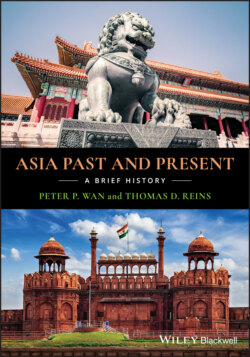Читать книгу Asia Past and Present - Peter P. Wan - Страница 31
The Land and the People in Paleolithic and Neolithic Times
ОглавлениеChina has had a relatively stable core population of Han Chinese throughout its history, and they continue to make up well over 90 percent of the entire modern Chinese population. China is also a multiethnic country composed of over 50 ethnic groups. Ancient Han Chinese believed for a long time that their country was at the center of the world, and called it the “Central Country.” They also believed that their land was the only civilized land, and so they called all the people living beyond their borders “barbarians.”
Early Han Chinese lived along the Yellow River. It had a loess soil that was highly fertile, a warm climate, and ample rainfall in ancient times. This richly endowed natural environment easily sustained plant, animal, and human life. But the rich silt in the rivers would frequently clog the riverbeds and cause serious floods. That is why the river is known not only as the “Cradle of Chinese Civilization” but also as “China’s Sorrow.”
Archaeologists unearthed the remains of China’s earliest humanlike beings at Zhoukoudian near modern Beijing. Known popularly as the “Beijing Ape Man” (Homo erectus pekinensis), they stood erect, used fire, and made crude stone tools. They acquired their food by hunting, fishing, and gathering. In one cave were found the skeletal remains of over 40 individuals of both sexes and all ages, over 100,000 items of crude stone tools, and layer upon layer of ashes. They date back to 700,000 years ago and belong to the Old Stone Age.
Archaeologists also found a human habitat at Banpo Village in the Yellow River Valley near modern Xian. Carbon dated to 6000 years ago, it had an estimated population of 400 to 600 people. Their dwellings were built in half‐pits covered with steep thatched roofs, they grew millet as their main food crop, and they kept sheep, goats, pigs, and dogs. They used stone tools and stone weapons. They were a people who had made the transition from the Old Stone Age to the New Stone Age and from hunting and gathering to agriculture and animal husbandry. They probably lived in a matriarchal society.
The dawning of Chinese civilization took place between the “Beijing Ape Man” and the Banpo people over a period of thousands of years. Artifacts of this period are rare, and those with symbols on them are not only rare but also difficult to decipher. Consequently, the picture they present is very murky.
Fortunately, these primitive ancestors of the Chinese were storytellers. Their stories were passed on by word of mouth from generation to generation, and later put down in writing by scholars. We call these stories myths. Myths are distorted reflections of the real‐life experiences of our primitive ancestors and their attempts at making sense of it all. Their knowledge and understanding of things were scrappy and incoherent, and they used their imagination to fill in the gaps. They created gods, godlike men and women, and part‐human and part‐beast or ‐bird figures who control everything in their universe. However inadequate, these myths provided people with a semblance of order in an otherwise chaotic, dangerous, and incomprehensible environment that threatened their very existence.
Savvy historians can extrapolate a wealth of information from these myths, and shed light on China’s murky prehistoric past. The central figures of the myths are called “culture heroes”; they are characters who represent entire developmental stages of human culture.
Chinese mythology has a “creation myth” just like other civilizations. In it, Pan Gu is the creator of heaven and earth. When he dies, his breath becomes wind, his voice becomes thunder, his left eye becomes the sun, his right eye becomes the moon, his limbs become mountain ranges, his blood becomes creeks and rivers, and his muscles become farm land. Nuwa Shi stands out as a female. She takes yellow clay to make the first humans in her own image, and then gives them male and female identities. Other “culture heroes” teach the people to hunt, fish, and domesticate wild animals; build treehouses; or make fires and cook food. Shennong Shi is the superhero. He enjoys the lofty title of “Immortal Patron of Agriculture” for introducing farming to hunting and gathering people, and teaching them to make farm tools and clay pots.
Dynasties and the “Dynastic Cycle.” Traditionally, the Chinese structured their chronology by dynasty. A dynasty is a period of time when a sequence of members from the same family rule. The Chinese also employ the term “dynastic cycle,” which means the repeating pattern of the rise and fall of one dynasty after another. Since history never repeats itself in exactly the same way, the dynastic cycle should be seen as a pattern with variations.
These terms may be less than scientifically accurate. But as tools, they are useful in structuring a narrative and in tracking time, events, regimes, and significant changes.
In traditional historiography, the mythical “culture heroes” are followed by the “Three Kings” of Yao, Shun, and Yu. They are allegedly elected king by their clan for their outstanding character and achievements. But Yu, who is elected king on his merit of saving his people from a great flood, passes his throne to his son Qi instead of giving it up to an elected successor. The Yu‐to‐Qi succession is from father to son. It ends the system of electing leaders, and launches the system of hereditary dynasties. Henceforth, birth, not merit, determines who is to rule. Qi’s Xia Dynasty is China’s first dynasty in traditional historiography. However, some modern historians are willing to use it only as a working hypothesis until solid physical evidence is found.
